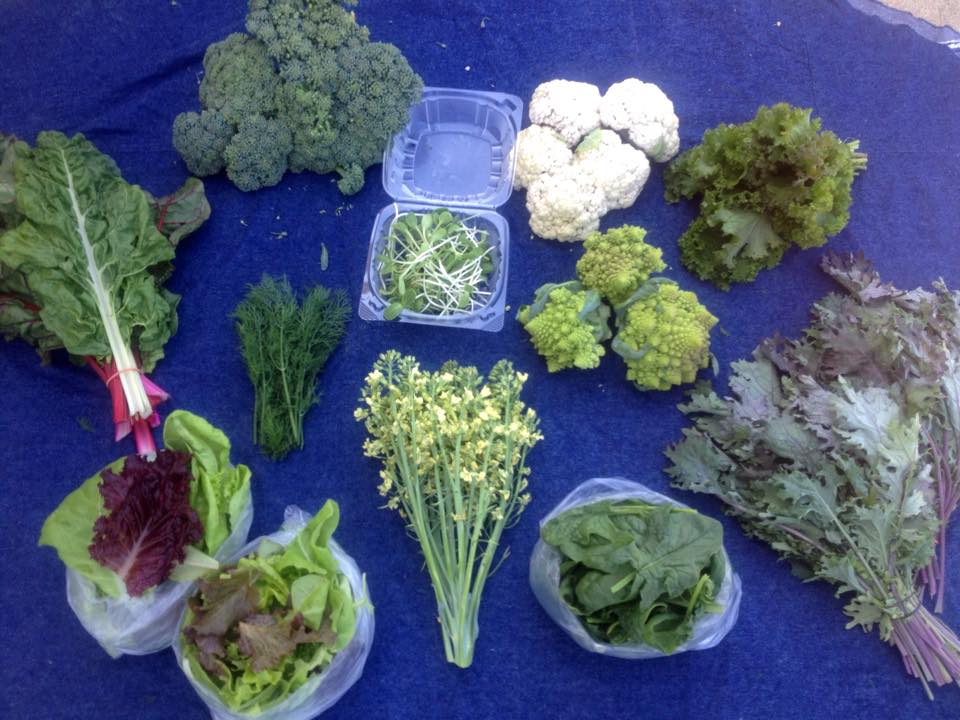For the week of April 13-18, here’s what we’re harvesting and delivering throughout greater Austin to our Blessing Falls CSA members. (If you’re not a member, we invite you to join)
Full share:
Cauliflower, Lettuce, Kale (double portions of each), Broccoli (triple portion),
Spinach, Microgreens, Dill, Broccoli flowers, Swiss Chard, Mustard or turnip greens
Half share:
Broccoli (double portion), Cauliflower, Lettuce, Microgreens, Spinach or Swiss Chard, Dill, Broccoli flowers
(Share contents may change slightly throughout the week depending upon harvest availability.)

Spring Week 3 Full Share: rainbow chard, broccoli, sunflower Microgreens, white and green cauliflower, mustard greens, lettuce, dill, broccoli flowers, spinach, kale
Meet Your Farmer
Sam is Michael’s 15 year old brother and our right hand man in the garden. He helps us with almost every gardening task. He’s an expert at planting, harvesting and packaging CSA shares. He’s also the Blessing Falls beekeeper! He’s the hardest working 15 year old I’ve ever known. He loves family and sports and his favorite thing to grow is broccoli!
Nutritional Facts
Quoted from Microgreens: Health Benefits and Nutrition Facts. We encourage you to read the whole article to learn more about microgreens and their amazing health benefits!
Turns out microgreens are not just a plain good-for-you food or a healthy garnish on salads and soups. Scientific research now proves that these tiny seedlings harvested and eaten when they are just a few inches tall are a real superfood packed with antioxidants and other health-promoting nutrients.
A team of scientists from the University of Maryland and the U.S. Department of Agriculture analyzed the nutrient composition of 25 microgreen varieties. They discovered that in general microgreen cotyledon leaves had considerably higher nutritional densities than their mature counterparts (cotyledon leaves refer to the embryonic first leaves of a seedling). This microgreen study was published in the August 2012 issue of the Journal of Agricultural and Food Chemistry.
Young edible seedlings are a superb source of vitamin C, an antioxidant that helps protect your body from the harmful effects of free radicals. The 2012 study on microgreens reported that even the microgreen sample that had the lowest levels of vitamin C contained a whopping 20 milligrams of vitamin C per 100 grams – that’s almost twice the amount of vitamin C found in tomatoes!
Carotenoids, such as beta-carotene, are thought to reduce the risk of disease, particularly certain types of cancer and eye disease. Turns out that many microgreens are also a good source of this important nutrient.” Microgreens also include many other nutrients such as antioxidants, vitamin E, vitamin K.
Recipes
We enjoyed trying these kale and broccoli smoothie recipes this week and hope you do too! Follow Blessing Falls on Pinterest to see more tasty recipe ideas!
Kale Smoothie
1/4 c. shelled pistachios
4 pitted dates
1/2 c. water
2 c. almond milk
1 Tbl. coconut oil
1 c. kale leaves
2 frozen bananas, cut in chunks
1 Tbl. maple syrup
1/2 tsp. vanilla
1 handful or so of ice
Heat the water in the microwave or on the stove until boiling. Add pistachios and dates, and let soak for 5 minutes. Blend other ingredients, except ice. Then drain water from nuts and dates, and add them to the blender. Blend until smooth. Add ice until it’s the texture you like.
Broccoli Smoothie
1 c. broccoli
1/2 an apple, chopped
1 1/2 c. almond milk
1 frozen banana
6 oz. pineapple-orange juice
1/2 avocado
1/2 tsp. vanilla
2 T. honey
1 handful or so of ice
Blend all ingredients until smooth, adding ice last.
We hope members enjoy their shares this week – we always value your comments and suggestions. And our CSA program remains open for new members. Sign up this week and you’ll get your first share next week, delivered right to your door. It’s that easy.
